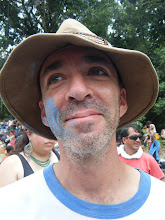We are picked up in the morning and drive to the pier and our boat which will be our home for the next two days. The upper level has a table and mattresses for us while below is the kitchen and place for our guide and crew. The toilet and shower is at the back of the boat. We leave town and cruise across a large river to the smaller river entrance of Tanjung Putting National Park.
 |
| Our vessel and floating studio apartment |
Each ranger station has feeding platforms for the orangutan. These feeding times are designed to help supplement the diets of the rehabilitated orangutans who are not fully accustomed to living without humans and living on their own in the forest. The platforms also are good for tourism because they make an easy way for people to see orangutans without traipsing all day through the jungle. Though the impact of tourism on the rehabilitated orangutans is yet to be determined (during our hike at Camp Leakey the next day we meet a university student following orangutans to study that exact thing). Another downside of a reintroduction program like this is that the wild orangutans may learn bad habits and not to fear humans from the rehabilitated apes. At times wild orangutans have been seen around the platforms eying the free bananas.
The first stop is at Camp Leakey, the farthest point from town. So we plug along upriver for several hours. A downpour starts -- it is rainy season -- so the bird viewing is minimal. This is also a difficult activity without binoculars. But the rain stops, as if by design, exactly as we pull up to Camp Leakey. Our guide leads us through the trail to the feeding platform and then right in front of us on the trail straddling two trees is a big female orangutan. It is exhilarating to see them this close.
There is a semi-circle of wood benches which face a platform about four feet off the ground. There is a large group of Indonesian tourists and five other foreigners. The guide tells us that according to the rules we should stay at least 5 meters (15 ft) from the orangutans, however, the apes here do not follow this rule. One mother continually stops at and passes over the benches where we are sitting. At this platform we see several nursing mothers clutching their infants while the younger children play around them. This is somewhat far from seeing actual wild orangutans, but nevertheless, a beautiful sight.
 |
| This just is not exactly the same as seeing orangutans in the wild |
 |
| The morning view from the boat |
 |
| Notice the ranger in the back coming to save us |
 |
| Jungle mushroom |
 |
| The gibbon |
Our last stop is for the 3:00 PM feeding at Tanjung Harapan station. We follow the ranger as he fills his basket with bananas and leads us on the short hike to the feeding platform. Above us we hear crashing through the trees and the growling of a male who is letting us know of his presence. It sounds intimidating to me, but the guides are unimpressed.
Unlike Camp Leakey where we saw many mothers with children, this feeding platform seems to be all young males who are too lazy to find their own lunch. One or two guys will be eating and as another approaches the ones at the platform will comically stuff their mouths full of unpeeled bananas and head up to the trees with their stash. None of the orangutans come near us either like in the other park. They all leave through the forest the way they came. The last to arrive this afternoon is a large male with the skin flaps on his face. He is not the king of this jungle, but at least we have a relatively close encounter with a really big ape. We see just one mother here who watches from high in the trees with her two children but does not come down to fraternize with the males.
 |
| Two males on the feeding platform |
Follow the links below for more detailed information about organizations working for conservation in Kalimantan:
Orangutan Foundation International - Doing research at Camp Leakey in Tanjung Puting National Park
The Borneo Orangutan Survival Foundation - They have several projects in Kalimantan
Nyaru Menteng - Training young orangutans to survive in the wild
World Wildlife Fund (WWF) - About their work at Sebangau National Park
Kalaweit - This organization is rescuing gibbons

















No comments:
Post a Comment